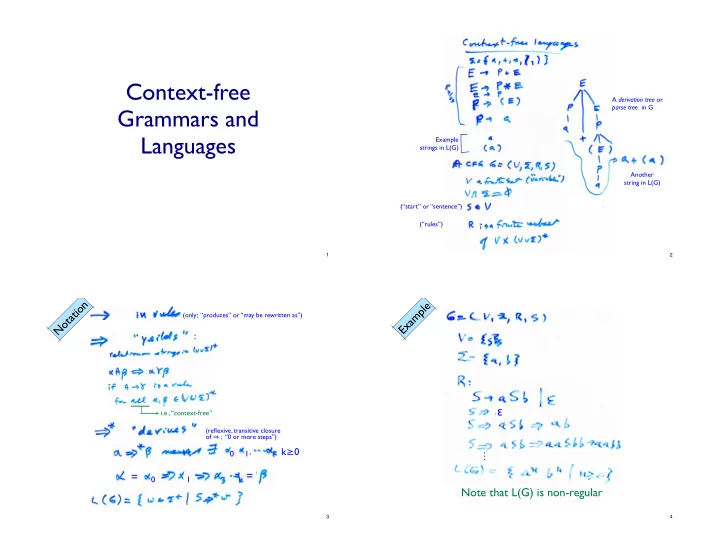

Context-free A derivation tree or parse tree in G Grammars and Languages Example strings in L(G) Another string in L(G) (“start” or “sentence”) (“rules”) 1 2 n e o l p i t m a (only; “produces” or “may be rewritten as”) t a o x N E : ε i.e., “context-free” (reflexive, transitive closure of ⇒ ; “0 or more steps”) k ≥ 0 0 1 ⋮ = = = 0 1 Note that L(G) is non-regular 3 4
E E x x a a m m p p l l e e We’ll see later that L two ={ww|w ∈ Σ *} is not context free. At first : glance, you might think that adding a new start symbol S’ and a rule S’ → SS to G 2 would generate L two , but it doesn’t; it generates all strings in L two plus many others, since derivations from the two S’s are not coordinated . (Why not? It’s context-free ; what happens to one S can’t influence the other.) 5 6 A grammar A tree Trees, Derivations and Ambiguity 3 derivations correspond to same tree (same rules being used in the same places, just written in different orders in the linear derivation) 1) E => P+E => a+E => a+P => a+a 2) E => P+E => P+P => a+P => a+a 3) E => P+E => P+P => P+a => a+a But only one leftmost derivation corresponds to it (and vice versa). (more in HW?) 7 8
Another grammar for the same language: E → E+E | E*E | (E) | a Fig 2.6: Two parse trees for a+a ! a in grammar G 5 Fig 2.6: Two parse trees for a+a ! a in grammar G 5 This grammar is ambiguous: there is a string in L(G 5 ) with two different parse trees, or, equivalently, with 2 different leftmost derivations. Note the pragmatic difference: in general, (a+a)*a != a+(a*a); which is “right”? 9 10 The “E, P” grammar again This grammar is un ambiguous. (Why? Very informally, the 3 E rules generate P((‘+’ ∪ ’*’)P) * and only via a parse tree that “hangs to the right”, as shown.) But it has another undesirable feature: Parse tree structure does not reflect the usual precedence of * over +. E.g., tree at lower right suggests “a * a + a == a * (a + a)” A more complex grammar, again the same language. This one is unambiguous and its parse trees reflect usual precedence/associativity of plus and times. 11 12
Can we always tweak the grammar to make it unambiguous? G Some closure results No! Language L is a CFL; grammar at left. Easy to see this G is ambiguous–strings of the form a n b n c n can come from the i=j (AC) or j=k (DB) for CFLs path. Hard to prove, but true, that every G for this L is also ambiguous. Intuitively, a grammar can only match a’s & b’s or b’s & c’s, not both. As a related point, { a n b n c n | n>0 } is not CFL. G is ambiguous L is inherently ambiguous , meaning every G for L is ambiguous 13 14 Proof: Closure under Concatenation Theorem: The set of context-free languages is closed under ∪ , •, and * V 2 Corollary: All regular languages are CFLs Proof Sketch: Directly give simple CFLs for ∅ , { ε }, and {a} for each a ∈ Σ . Combine them using the above theorem. (Aside: We’ll later prove that CFLs are not closed under G 2 G 1 intersection or complementation.) G G G 15 16
G Then, for some x, y ε Σ * G G A key issue in this direction of the proof is that, since V 1 ∩ V 2 = ∅ , there is no “crosstalk” between the two sub-grammars: any derivation in G from S 1 is also a derivation in G 1 , and likewise S 2 /G 2 , so derivation (*) above in G can be split into (**) in G 1 & G 2 . 17
Recommend
More recommend